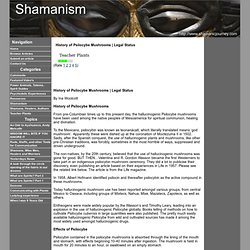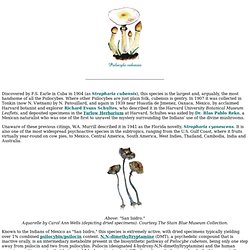

History of Psilocybe Mushrooms. History of Psilocybe Mushrooms | Legal Status By Ina Woolcott History of Psilocybe Mushrooms From pre-Columbian times up to this present day, the hallucinogenic Psilocybe mushrooms have been used among the native peoples of Mesoamerica for spiritual communion, healing and divination.

To the Mexicans, psilocybin was known as teonanácatl, which literally translated means ‘god mushroom’. Apparently these were dished up at the coronation of Moctezuma II in 1502. The non-natives, by the 20th century, believed that the use of hallucinogenic mushrooms was gone for good. In 1958, Albert Hofmann identified psilocin and thereafter psilocybin as the active compound in these mushrooms. Today hallucinogenic mushroom use has been reported amongst various groups, from central Mexico to Oaxaca, including groups of Mixtecs, Nahua, Mixe, Mazatecs, Zapotecs, as well as others. Effects of Psilocybe Some find themselves hooked on the substance, and may need treatment and recovery from mushroom addiction later on. Psilocybe cubensis/Psilocybe subcubensis.
Discovered by F.S.

Earle in Cuba in 1904 (as Stropharia cubensis), this species is the largest and, arguably, the most handsome of all the Psilocybes. Where other Psilocybes are just plain folk, cubensis is gentry. In 1907 it was collected in Tonkin (now N. Vietnam) by N. Patouillard, and again in 1939 near Huautla de Jimenez, Oaxaca, Mexico, by acclaimed Harvard botanist and explorer Richard Evans Schultes, who described it in the Harvard University Botanical Museum Leaflets, and deposited specimens in the Farlow Herbarium at Harvard. Unaware of these previous citings, W.A. Above: "San Isidro. " Known to the Indians of Mexico as "San Isidro," this species is extremely active, with dried specimens typically yielding over 1% combined psilocybin/psilocin content. Above: Psilocybe cubensis, Texan strain.Aquarelle by Carol Ann Wells (depicting dried specimens). Above: "Symbiosis. " The Crested Caracara is another bird that frequents the pasturelands of Texas and Mexico.
Required Reading. Psilocybe cubensis. CAP: 1.5-8 (10) cm broad, broadly conical or oval or bell-shaped (often with an umbo ) when young, gradually expanding to convex, broadly umbonate, or plane; surface smooth or with small whitish veil remnants when young, viscid when moist, soon dry, color variable: whitish with a brown to yellowish center, or entirely yellow to yellowish-buff to yellow-brown, or sometimes cinnamon-brown when young and sometimes dingy olive in old age; bruising and aging bluish; margin sometimes hung with veil remnants.

Flesh firm, white, staining blue or blue-green when bruised. GILLS: Close, adnate to adnexed or seceding to free; pallid, soon becoming gray, then deep purple-gray to nearly black; edges whitish. STALK: 4-15 cm long, 0.4-1-5 cm thick, equal or more often thicker below, dry, white or sometimes yellowish to yellow-brown, aging or bruising blue or blue-green; smooth. EDIBILITY: Hallucinogenic. Is not as powerful on a dry weight basis as Psilocybe cyanescens, but is larger. Psilocybin Mushroom (Magic Mushrooms) Vault.